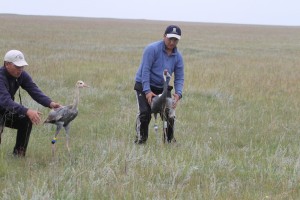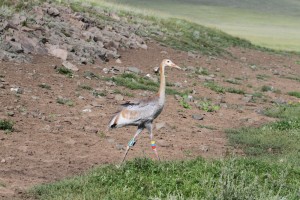In a warm and sunny Mongolia the spring is heralded by birdsong everywhere and the arrival of the White-naped Crane.
The spring migration of the Mongolian population returning to breeding grounds, on March 10th brought one adult female White-naped Crane to Duolin, in southern Inner Mongolia. This is an area where the cranes stopped for several weeks during their southbound autumn migration. Dr. Nyambayar Batbayar of the Wildlife Science and Conservation Center of Mongolia, with colleagues from the International Crane Foundation and support from the US Forest Service, fitted birds with transmitters in Mongolia before their autumn migration in August 2013. Three of these birds still have functioning transmitters. The other two birds (both juveniles) are now in Miyun Reservoir, 80 km northeast of Beijing, another location used by these cranes last year.
[/one_half_last]
Valuable information can be learned about migration each year, as conservationists follow birds using satellite and cell phone tracking technologies. It is from such activities that we are able to discover the routes taken from breeding to wintering locations, gathering information on crucial stopover sites, of great importance for refueling before the next long distance flight.
Supporting the conservation of migratory birds is a complex process involving many habitats and ecosystems across many international borders. The tracking data has so far identified Duolin and Miyun Reservoir as two important locations for White-naped Crane migration within China. The research team continues monitoring the migration hoping to identify similar important stopover sites in Mongolia as well. These data, along with data being collected from the ground by colleagues from Beijing Forestry University in China, will enable us to assess the importance and status of these stopover sites and provide recommendations to strengthen conservation efforts. The team from Beijing Forest University is also collaborating with the Poyang Lake Nature Reserve and ICF to study movements and behavior on the wintering grounds at Poyang Lake.

White-naped crane migration data as of 25 March 2014 © Wildlife Science and Conservation Center of Mongolia
For further information please contact Nyambayar Batbayar (nyambayar@wscc.org.mn) or Li Fengshan (Fengshan@savingcranes.org).






